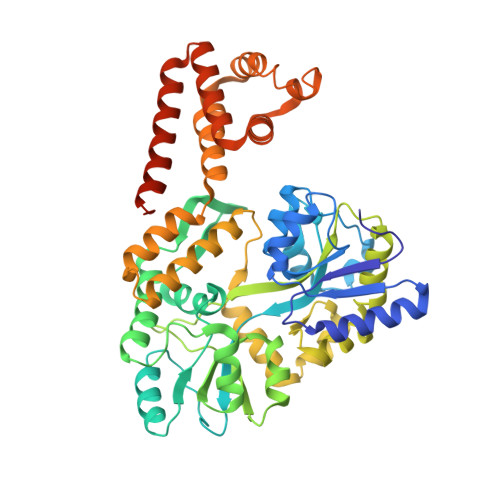Structure of the Absent in Melanoma 2 (AIM2) Pyrin Domain Provides Insights into the Mechanisms of AIM2 Autoinhibition and Inflammasome Assembly.
Jin, T., Perry, A., Smith, P., Jiang, J., Xiao, T.S.(2013) J Biological Chem 288: 13225-13235
- PubMed: 23530044
- DOI: https://doi.org/10.1074/jbc.M113.468033
- Primary Citation of Related Structures:
3VD8 - PubMed Abstract:
AIM2 binds dsDNA and associates with ASC through their PYDs to form an inflammasome. The AIM2 PYD structure illustrates distinct charge distribution and a unique hydrophobic patch. The AIM2 PYD may bind the ASC PYD and the AIM2 HIN domain through overlapping surface. These findings provide insights into the mechanisms of AIM2 autoinhibition and inflammasome assembly. Absent in melanoma 2 (AIM2) is a cytosolic double-stranded (dsDNA) sensor essential for innate immune responses against DNA viruses and bacteria such as Francisella and Listeria. Upon dsDNA engagement, the AIM2 amino-terminal pyrin domain (PYD) is responsible for downstream signaling to the adapter protein apoptosis-associated speck-like protein containing a caspase recruitment domain (ASC) through homotypic PYD-PYD interactions and the assembly of an inflammasome. Toward a better understanding of the AIM2 signaling mechanism, we determined the crystal structure of the human AIM2 PYD. The structure reveals a death domain fold with a short α3 helix that is buttressed by a highly conserved lysine residue at the α2 helix, which may stabilize the α3 helix for potential interaction with partner domains. The surface of the AIM2 PYD exhibits distinct charge distribution with highly acidic α1-α2 helices and highly basic α5-α6 helices. A prominent solvent-exposed hydrophobic patch formed by residues Phe-27 and Phe-28 at the α2 helix resembles a similar surface involved in the death effector domain homotypic interactions. Docking studies suggest that the AIM2 PYD may bind the AIM2 hematopoietic interferon-inducible nuclear (HIN) domain or ASC PYD using overlapping surface near the α2 helix. This may ensure that AIM2 interacts with the downstream adapter ASC only upon release of the autoinhibition by the dsDNA ligand. Our work thus unveils novel structural features of the AIM2 PYD and provides insights into the potential mechanisms of the PYD-HIN and PYD-PYD interactions important for AIM2 autoinhibition and inflammasome assembly.
- Structural Immunobiology Unit, Laboratory of Immunology, NIAID, National Institutes of Health, Bethesda, MD 20892-0430, USA.
Organizational Affiliation:




















